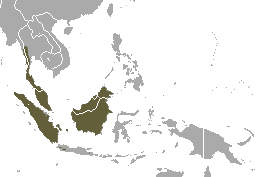Banded linsang facts for kids
Quick facts for kids Banded linsang |
|
|---|---|
 |
|
| Conservation status | |
| Scientific classification | |
| Genus: |
Prionodon
|
| Species: |
linsang
|
 |
|
| Banded linsang range | |
The banded linsang (scientific name: Prionodon linsang) is a cool, tree-dwelling mammal that lives in the forests of Southeast Asia. It's a type of linsang, which are small, cat-like animals known for being good hunters.
What Does It Look Like?
The banded linsang is about 35–41.1 cm (13.8–16.2 in) long, which is roughly the size of a house cat. Its tail is almost as long as its body, reaching up to 36.2 cm (14.3 in)!
This animal has pale yellow fur with five dark bands across its body. It also has wide stripes on its neck. Its long tail has seven or eight dark bands and a dark tip. On average, a banded linsang weighs around 700 g (25 oz), which is less than a bag of sugar. It also has super sharp claws that it can pull back, just like a cat!
Where Does It Live?
Banded linsangs are found in several countries in Southeast Asia. You can find them in southern Myanmar, Thailand, Malaysia, and on islands like Borneo, Sumatra, Java, Bangka, and Belitung Islands.
These animals mostly live in thick, green evergreen forests. Sometimes, they are also seen in forests where trees lose their leaves, called deciduous forests. They have even been spotted near oil palm farms in some areas. In 2013, a camera-trap caught a picture of a banded linsang for the first time in the hill forests of Karen State.
How Does It Live?
The banded linsang is a nocturnal animal, meaning it is most active at night. It usually lives alone and is a carnivorous hunter. Its diet mainly includes small animals like birds, rats, and snakes.
Scientists don't know much about how banded linsangs have babies. It's thought that they might have two or three babies at a time, possibly twice a year. They likely make their nests in burrows or inside hollow trees.
How Scientists Classify It
For a long time, scientists thought that Asiatic linsangs, like the banded linsang, belonged to the same family as genets, which are similar-looking animals. This family was called Viverridae.
However, new studies using genetic information (like DNA) have shown something surprising! These studies suggest that Asiatic linsangs are actually very closely related to the cat family, Felidae. Because of this, scientists have suggested putting the Asiatic linsangs into their own special family called Prionodontidae.


